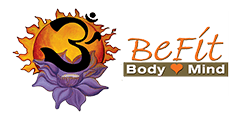BELLY BREATH, THORACO-DIAPHRAGMATIC BREATH, CHEST BREATH
Free breathing is one of the most fundamental aspects of practice. Free breathing means that there is a sense of ease expressed in the breath — that the transitions between inhalation and exhalation are smooth, strain free. This releases tension and frees the circulation of blood and energy in the body. Circulation flushes away stagnation, toxins and stiffness. The awareness required to maintain free-breathing develops concentration and ease of effort.
Many of us “breathe backwards”, before we breathe freely, we must breathe correctly.
The first breath to learn is the belly breath. Abdominal breathing lowers heart rate and blood pressure, it is a calming and soothing breath due to the fact that it involves the least amount of muscular involvement.
This breath is easiest to learn lying supine as in rest pose (savasana). Try this inquiry: Lie supine with your hands laying on your belly. Inhale and expand your abdomen in all directions (feel your hands move outward/upward). Exhale relax and allow the belly to fall in. Breathe into your hands and feel them move with the belly breath.
It is best to practice this during an “ideal” situation (low dis-stress). During a stressful time you will be able to recall this breath to help you relieve your stress level. During times of dis-stress you may not be able to lie down, and you will find it more difficult to pull your breath down to your belly. You can use your abdominal muscles to help you get a hold of your breath, this exercise is best done seated but can be done anywhere even while standing.
Exhale and push inward and upward to empty the air out of your lungs with your abdominal muscles, then relax and allow the inhale to enter your body effortlessly. Feel your breath all the way down to your lower abdomen as you inhale.
Progress to: Sit in a comfortable position. Regulate your breath to a 2-second inhale and exhale. Use your abdominals to facilitate smooth junctions between your exhales and inhales. Imagine an ellipse, the exhalation going down and around and the inhalation going up and around, one count each second: down, down, up, up . . . Create an image in your imagination where you are actively pressing in with the abdominal muscles during exhalation and releasing them outward during inhalation. Still riding the ellipse, think travel down the ellipse and push in, travel up the ellipse and ease out: down and in, up and out. This exercise helps you to keep the breath smooth.
The belly breath is good for stress relief, however you do not want to stay there all day long as it can leave you feeling lethargic. The breath you want for most of your day is the thoraco-diaphragmatic breath (rib cage area).
This breath is energizing and requires the support of the abdominal muscles (bandhas). This encourages correct posture and spinal support. Many of the principals of abdominal breathing apply to thoraco-diaphragmatic breathing. Except it is a little more complex as you are constantly using your abdominals to breath. The belly breath when done correctly also uses the diaphragm to breathe, with the relaxed posture of the belly breath, the diaphragm descends, with the thoraco-diaphragmatic breath, the upward lift of the abdominals is not allowing the diaphragm to descend.
To breath thoracically, hold your navel inward and upward (subtly!). Now expand your rib cage as you inhale (not your abdomen). Feel your in breath expand the rib cage area of your body — it is the strength of the abdominals pushing upward against the diaphragm that causes the diaphragm to expand outward into the rib cage instead of downward into your belly. Feel your out breath relax your ribs inward.
Chest breathing, there are two types:
Empowered and Constricted.
Empowered breathing happens mostly during exercise or more strenuous yoga postures, we utilize our full chest cavity to take in more breath, this is the “good” kind of chest breathing.
Constricted chest breathing tends to be habitual in nature.
Both the inhale and exhale are shallow and tentative, and there is abnormal upper body tension in the face and neck. Chest breathing invokes the fight or flight response in our body preparing us for action. This is OK if you are exercising as your body uses the hormones. If you are not in movement (like running for your life!) the hormones released stay in your blood stream. A build up of these hormones (adrenaline and cortisol) stay in the blood stream keeping our body in a state of alarm. Elevated levels of cortisol in the blood stream have been linked to increased risk of heart disease. The antidote for chest breathing? Abdominal breathing.
